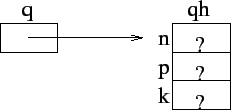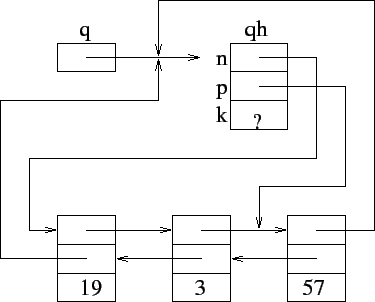
CS 325
Due Feb. 3, 2012
For this project you will write a simple module that does queue
manipulation. While this program is perhaps not very interesting in its
own right, it will allow you to ``brush up'' on some of the finer points of
C -- namely structs, pointers, and dynamic memory allocation.
In coding, be sure to follow good programming practices and consistent conventions -- I don't care that your conventions are not my conventions, but your conventions must be both reasonable and consistent. In particular, remember to carefully document each module's interface, data structures, and specification (what the module does, but not how it is implemented).
The files queue.h and queue.c on the class home page comprise
the queue module. queue.h is complete. queue.c contains
stub functions that you will complete. See ``Testing'' below for what to
do with test.c.
This module implements and maintains a number of queues that can be maintained in either FIFO (first-in-first-out) or key order. The queue elements are of type qnode:
typedef struct qnode {
struct qnode *next;
struct qnode *prev;
int key; \\
/* other things would go here */
} qnode;
qnode is defined in the header file queue.h. A queue is implemented as a doubly-linked list using the next and prev fields to point to the succeeding and previous elements, respectively. The queue itself is represented by a pointer to a queue header, a structure of type qnode which is not considered to be an element of the queue. If the queue is empty, the next and prev fields of the queue header point back to the header itself.
By way of illustration, one would create the queue q this way:
qnode qh; /* qh is a qnode. */ qnode *q = &qh; /* q is a POINTER to a qnode, initialized to point to qh. */Following the initialization of
q, our memory model looks like this:

Note that the next, prev, and key elements of
qh are uninitialized. In this context, we typically use q to
access the members of qh rather than qh itself. To directly
initialize the key field to 5 using qh we would write:
qh.key = 5;To accomplish this with the pointer
q we would have to first
dereference q using the pointer dereference operator (*) and
then apply the member selection operator:
(*q).key = 5;This operator pair occurs so frequently that there is a single operator that handles both of them at once:
q->key = 5;
An empty queue looks like this:

A queue with three items would look like this:

Recall that a queue is ordered. What is the key value of the first item in
the queue? What pointer expression could be used to change the key value
3 in the queue to 33?
The module should have the following externally visible functions:
void initqu(qnode *queue)
Initialize the queue header pointed to by queue to be the empty queue. The header node must already exist.
int emptyqu(qnode *queue)
Return 1 if the queue is empty, 0 if it is not.
void insqu(qnode *queue, qnode *element)
Insert the element pointed to by element into the queue of which queue is a member, immediately after the element pointed to by queue. This function may be used to insert at either the beginning or the end of a queue. Suppose the queue header is pointed to by a variable named q. Then to insert an element element at the end of the queue use insqu(q->prev, element) and to insert at the beginning of the queue, use insqu(q, element).
qnode *remqu(qnode *element)
Remove the queue element pointed to by element from whatever queue it is in, returning that element itself. Exception: If the element is the only thing in the queue (i.e., the header of an empty queue), then leave the queue unchanged and return NULL. This function may be used to remove from either the beginning or the end of a queue. Suppose the queue header is pointed to by a variable named q. Then to remove the first element in the queue use remqu(q->next) and to remove the last element, use remqu(q->prev). If you are not careful, you can remove the queue header, effectively destroying the queue.
void ordinsqu(qnode *queue, qnode *element)
Insert the element pointed to by element into the queue whose header is pointed at by queue based on the value in the key field. The queue should be maintained in increasing order by key value; if one or more elements already exist with the key value of the given element, insert the new element after the existing elements.
qnode *ordremqu(qnode *queue, qnode *val)
Remove the first element in the queue whose key value is val and return it. If the queue is empty or a element with the given value does not exist, return NULL and leave the queue unchanged.
Create a new C Project in Eclipse with the CDT perspective or use your
favorite C compiler. Add the three files queue.h, queue.c,
and test.c to your project.
Build the project. It should compile and link with a few warnings
(remember -- queue.c contains stubs). Running it will generate a
memory access exception due to a dangling pointer. Complete the stubs in
queue.c. test.c is a test driver module. The test module
reports on its progress by posting messages to stdout. It will
attempt to diagnose errors, but its analysis is primitive.
Hints: None of the functions should require more than a dozen lines of
code. ordinsqu() and ordremqu() may make use of
insqu() and remqu(), respectively.
Email queue.c as an attachment to kelliher[at]goucher.edu by the
beginning of class on the 3rd. Late assignments will only be accepted by
prior agreement.